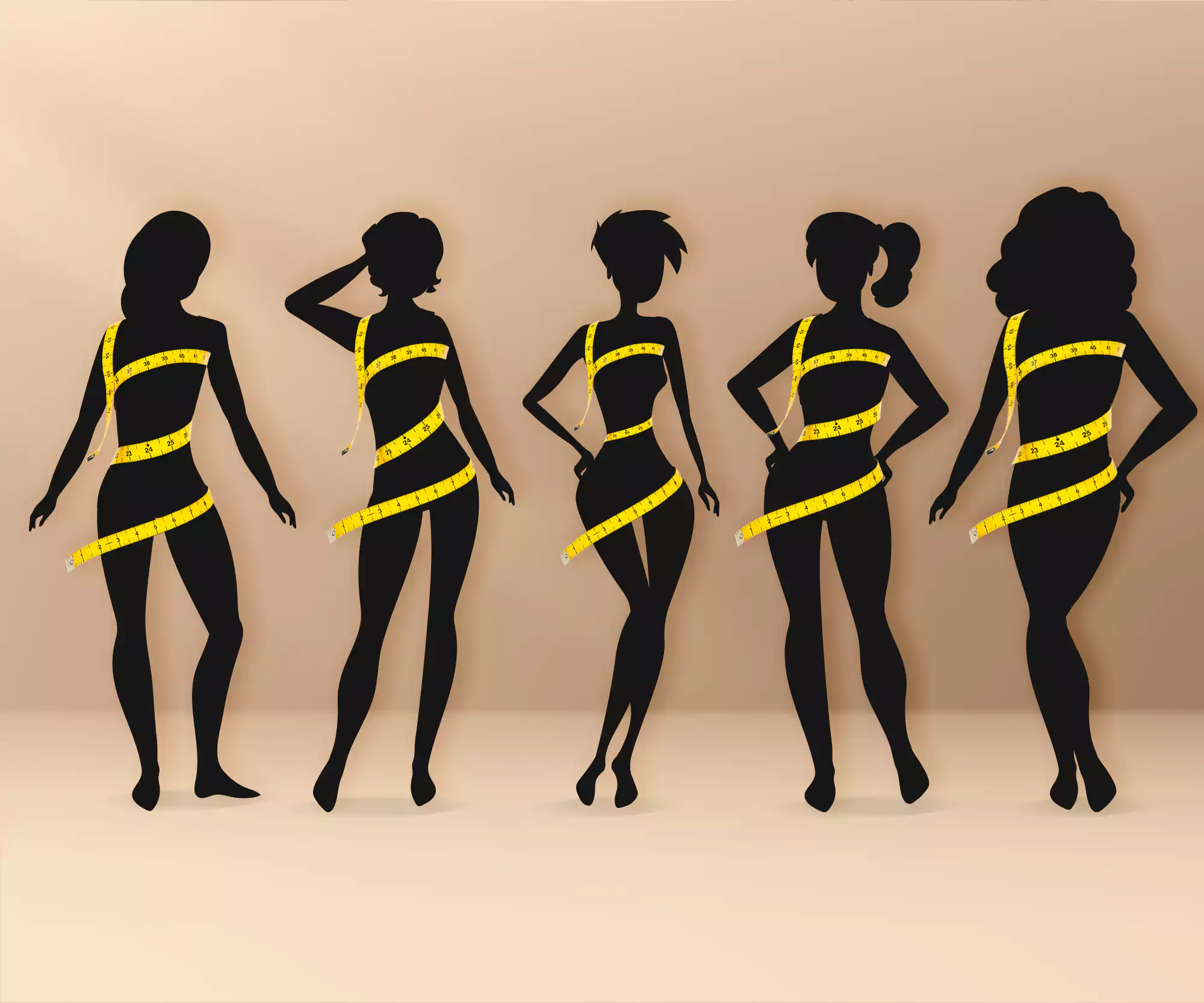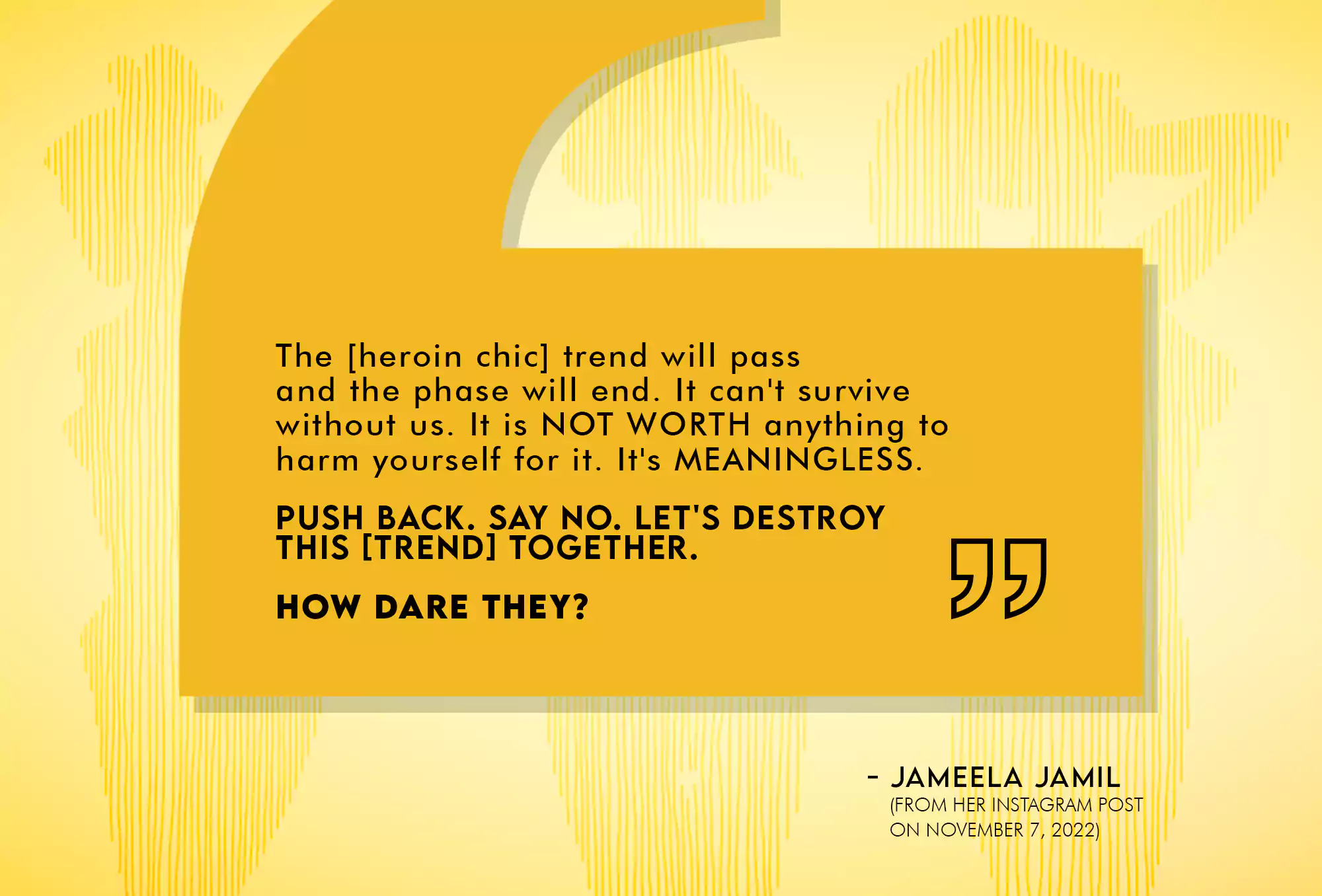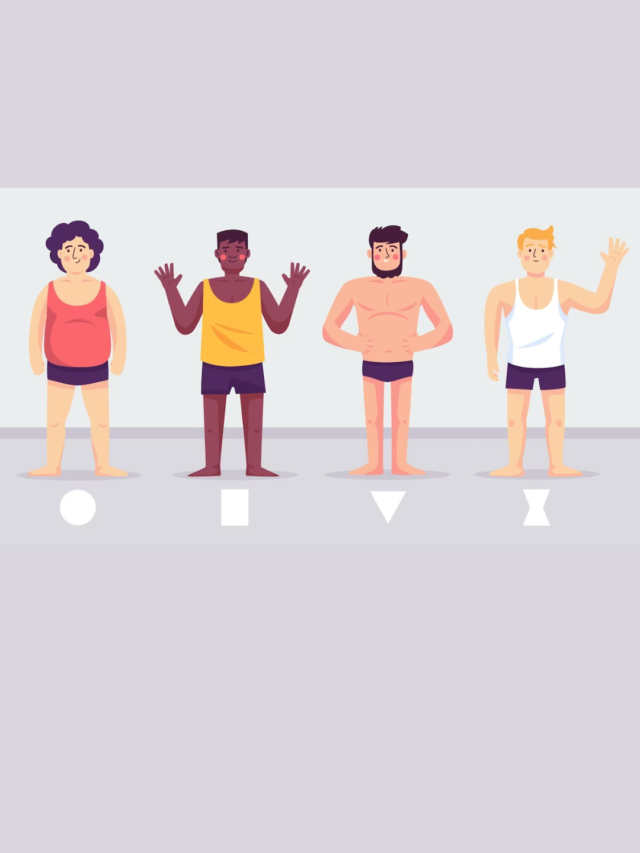
The body has been considered a fashion accessory for at least a century. I say this as a grown woman who understands that she has an unhealthy relationship with her body but cannot seem to do anything about it. It triggers me whenever a ridiculous ‘body trend’ threatens to turn another generation of teens into body dysmorphic, anorexic, unhappy, unhealthy people. Though this may seem like an overreaction, I cannot honestly think of a single teenager with a healthy relationship with food and their body. So it comforts me to know that I have found a kindred spirit in British actress Jameela Jamil. Jamil raises all the hell I want to raise with these issues. So when the New York Post published an article proclaiming the resurgence of ‘heroin chic’, she went on the offensive. She wrote an article against it in Paper Magazine, condemning the so-called revival and other harmful weight-loss practices that prevail in Hollywood. I second her announcement of the need to discuss the glaring issues with this trend, so here are my agitations with ‘heroin chic’ and all those other destructive body goals.
What in the world is ‘heroin chic’?
Bye bye booty: Heroin chic is back https://t.co/D5yTMWQfWh pic.twitter.com/a7r4a6RzGv
— New York Post (@nypost) November 2, 2022
It’s time for a history lesson. The 1980s was the era of the Supermodel. Think Cindy Crawford, Naomi Campbell, Brooke Shields, and Princess Diana—still considered ideals of beauty. The ’80s girl was athletic, vibrant, fresh, and able to make those spandex leggings look good.
In the ’90s, it seemed the fashion industry got sick of this look and decided that the new ‘in’ thing was to look emaciated. They called this heroin chic, and the whole idea was that you were so thin that you looked sick, like you were addicted to the drug. Model Gia Carangi is credited with having started this trend. Unfortunately, she was a heroin addict and died of AIDS-related complications. Substance abuse has long been a staple in the fashion industry’s underbelly. It claimed the life of famed photographer Davide Sorrenti, who died at 20. Granted, it was partly because of thalassemia (a genetic blood disorder), but the heroin he was always surrounded by could not be ignored. His mother launched a campaign against heroin chic, of which her son was a huge proponent.
So by the 2000s, heroin chic was out, only to be replaced by a new body type: Bombshell. Two words—Victoria’s Secret. Then came the curvaceous ideal of the 2010s—built almost exclusively by the Kardashian empire. And now, in 2022, celebrities are losing weight rapidly, and sickly thin is back—also a la the Kardashians. Kim Kardashian’s drastic measures (involving sauna suits, amped-up workouts, and punishing diets) to fit into Marilyn Monroe’s dress may have set that boat sailing.
The female body through the ages
We know that the big names in the fashion industry determine the ideal body type of any given era. Somehow, it is not enough that women strive towards summer bodies every May. Still, they must change their entire bone structure every ten years. It all started in the 1920s. Women were finally beginning to express themselves and have their own identities. However, they faced limitations too. Fashionable flappers flaunted their boyish figures, even if it meant taping their breasts. Simultaneously, readymade clothing was all the rage. The fashion industry no longer made clothes to fit the person; the person would have to fit the clothes. In the ’50s, they had this down to an art. After World War II, ideals became more conservative. This era saw the emergence of the All-American Woman—Playboy, Barbie, and Marilyn Monroe.
The whole thing was also racist if you think about it. It is genetically and ethnically impossible for some people to follow this beauty standard. While the earlier ideal body types had something to do with reproduction (child-bearing hips and such), the 20th century fluctuated between full figures and androgyny. So, in a woman’s lifetime, she may be considered attractive or unattractive at different stages of her life. This unsteady and unnecessary critiquing principle can be quite jarring, as you can imagine. Before you know it, the everyday woman wants to join her Hollywood counterparts, struggling with self-image, changing things, tweaking this and that. This is all only temporary until she receives a new manual of beauty in a few years. What was fashionable ten years ago becomes ugly ten years later. How can body dysmorphia not thrive in such a system?
The arbitrary ‘perfection’ of body trends
Indeed, women must have had different body types in every era. But they have been virtually erased. As a result, women from a specific historical period always appear to have ‘acceptable’ body types when depicted today.
Unrealistic body expectations start at alarmingly early ages for little girls. From Cinderella (1950) to Frozen (2013), Disney princesses have maintained impossibly narrow waists and tiny wrists throughout the decades. Big feet and warts belonged to ugly step sisters and old witches for decades before the likes of Moanna hit the screens to diversify body features with her athletic build. These problematic decades instilled a warped notion that women all have the same body across ethnicities.
The perfect body is different from country to country. So, for example, beauty standards in China are different from those in Mauritania. But since body trends originate in America, as most things do, the world also tends to imitate American beauty standards. And because of the exposure of teens worldwide to this narrative, primarily through social media, the problem is very much a universal one.
Are men also victims of body trends?
Though nothing at all compared to the ever-changing demands made on the female body, the male body is also subject to some very unhealthy standards. Take, for example, the insistence on a muscular, six-pack body that looks good in a suit. Men must be tall, have chiselled jawlines, and have great hair. They have to clock taxing hours at the gym to attain unsettling descriptors like ‘cut’, ‘ripped’, or ‘jacked’. Here also, we notice foul play by anabolic steroids, and it’s a war with drugs all over again.
In complex racial settings, we find that different components of different races together form the ideal beauty standard. For example, German features with a tan body are considered attractive in Brazil. In the Philippines, on the other hand, people prefer Spanish and American masculine ideals. Moreover, manscaping and hairlessness are becoming more prevalent, and hairy bodies are considered comical. Additionally, men should not appear as if they are trying too hard—they need to look good, but should not appear as if they are working too hard.
Why is heroin chic coming back?
There’s this new drug on the market—Wegovy (semaglutide). It is for those suffering from morbid obesity or chronic illnesses in conjunction with obesity. However, rich folk have already started misusing this drug to lose weight rapidly. One visit to their site will show you just how many red flags this injection has. They openly share its side effects, including cancer, vision problems, and depression. I am horrified that this is on the market, but it probably helps people who need it. We don’t know because the research (as mentioned on the site) is still in its early stages. So, anyway, with the help of this potentially dangerous drug, a new kind of body is emerging. Once again, substance abuse is becoming fashionable—a different substance, but still bad.

Fashion is art. But is it right to objectify the human body to the point where a destructive approach leads to deaths from substance abuse and eating disorders? We have come so far, and we know so much better now. Our bodies should not limit us again. We have things to do, places to go, and people to be.
Bodies are not fashion accessories.



